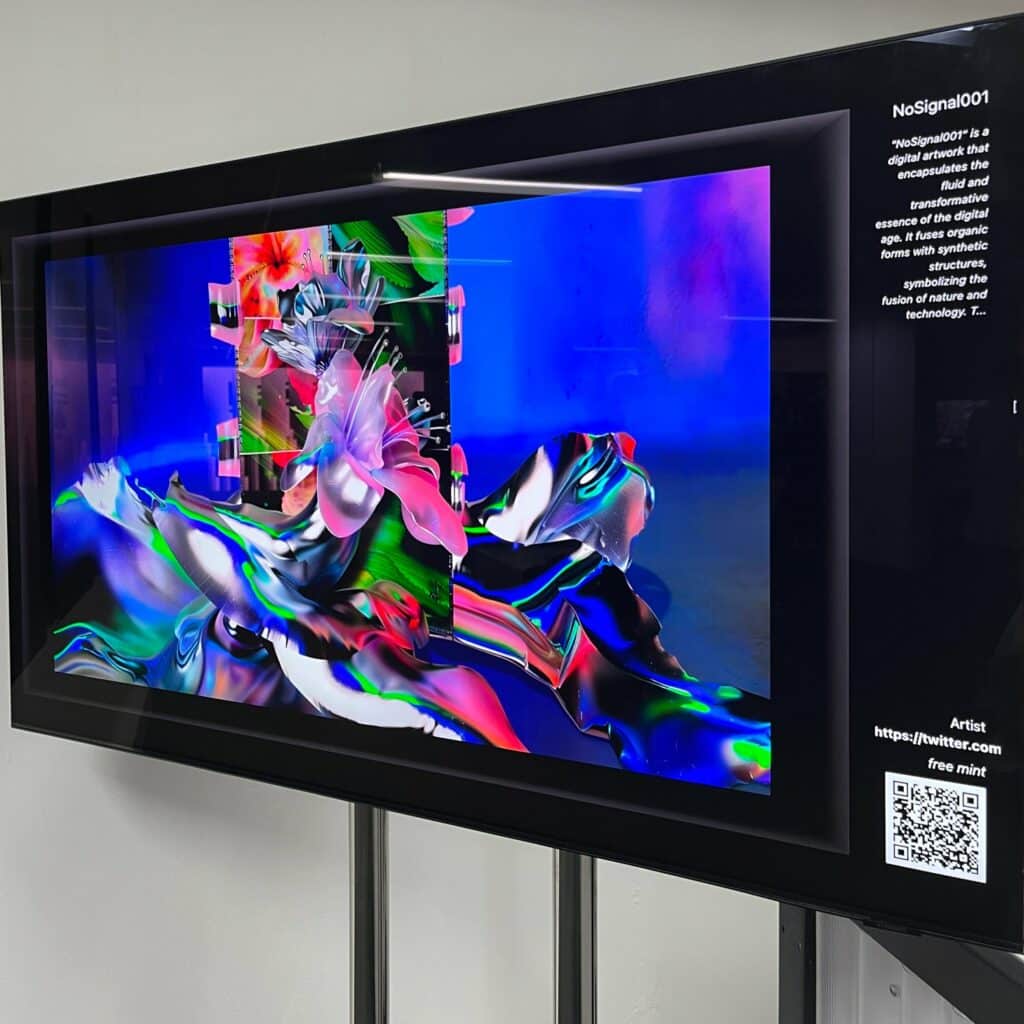The Sigg Art Foundation, Digital Art Mile, TAEX and Tezos are all in Basel this year to present NFTs in an effort to highlight the expanding role of digital art in the global art ecosystem.
The Digital Art Mile, an innovative digital art market held alongside one of the world’s oldest and most prestigious art fairs, Art Basel. This event transformed Rebgasse, near Art Basel in Basel, into a vibrant showcase for contemporary and historical digital art. Internationally renowned galleries and NFT platforms were invited to come together to present their collections at several exhibition venues, creating a dynamic intersection of traditional and digital art forms throughout the week.
The first Digital Art Mile, which took place from June 10-16, featured a number of well known exhibitors such as Objkt, fx(hash), Fellowship, MakersPlace, Cinello, RCM Galerie, ArtXCode, Office Impart, TAEX, Danae, Sigg Art Foundation, GENAP Collection, and Blackdove.
Over at the booth of the Sigg Art Foundation, which itself was founded in 2020 by longtime art collector Pierre Sigg, organized an exhibition featuring pioneering digital artists Grégory Chatonsky, Justin Aversano, Ben Elliot, and Bernar Venet.
Venet’s work was presented in conjunction with Sotheby’s: EVENT, showcasing a collection of 500 algorithmic artworks, a key theme that ran through many of the other digital offerings on display.
Chatonsky, a pioneer in incorporating AI into contemporary art, introduced a new version of his installation, “Terre Seconde”. Initially exhibited at the Palais de Tokyo in 2019, this installation is generated from millions of data points—images, texts, and sounds—sourced from the internet, offering a dynamic, modular structure that reimagines our planet in a form that is familiar yet distinctly unique.
Complementing Chatonsky’s AI-driven approach, the American artist Justin Aversano, fresh from a world tour that saw him traverse the world in search of human stories, brought to Basel some of his most unique works, including photographs of twins he compiled all over the world.
Further enriching the foundation’s showcase, Elliot showcased a work called “Metaone”, an ambitious virtual reality project produced by VIVE Arts with the support of Esther Schipper Gallery in Berlin. “Metaone” delves into a futuristic virtual paradise where history, nature, technology, and science coalesce, offering a visionary perspective on the evolution of creative spaces.
Meanwhile, the Tezos Foundation introduced two main platforms in its ecosystem: Objkt and fx(hash), which explore physical representations of digital art by fostering dialogue and experiencing journeys through revolutionary curation in the generative art space.

The Swiss platform Objkt also hosted the “Matter & Data” exhibition, which features works by 17 international artists. In addition, Objkt have displayed their collaboration with Analivia Cordeiro, a Brazilian inventor of cybernetic choreography, to present an interactive exhibit in which visitors can transform their movement patterns into generative NFTs on the Tezos blockchain.
Regina, Silveira, Auriea Harvey, ThankYouX, Oona, Leander Herzog, Zancan, and Qubibi are among the other artists represented at the booth.
fx(hash), a generative art platform, curates code-based artworks that demonstrate cultural and technological linkages between digital and physical formats and proposes rethinking them in light of contemporary and historical urgencies. In collaboration with OFFICE IMPART, the platform presented ‘Bit Operations’, a visual examination of computer foundations through bit-shifting operations, by Swedish artist Jonas Lund. Lund’s project included a long-form generative collection that collectors may access online through fx(hash), as well as curated limited edition tangible works combined with the generative output shown during the fair.
Also among the exhibitors, the digital art platform and agency TAEX, presented a captivating digital Zen landscape from the Continuum project by Krista Kim. Created as a response to the distractions of technology, Kim’s work transforms digital screens into spaces of mindfulness and contemplation.
The collection, consisting of 10 unique NFTs derived from the whole Continuum artwork, invites collectors to engage with meditative visuals that evolve subtly over time. These pieces reflect Kim’s inspiration from the serene Ryoanji Temple Garden in Kyoto, aiming to reconnect viewers with tranquility through digital interfaces.
Meanwhile, Fellowship took what was perhaps the most ambitious work in the Digital Art Mile, an event space almost 300 square meters to provide a pioneering survey of the growth of AI in recent art history. The exhibition, “Collaborations with the Artificial Self.” honors Harold Cohen, the original father of artificial intelligence in art, and includes the sole self-portrait ever created by his painting machine Aaron.
The initial works inspired in 2015 by Elman Mansinov’s AlignDraw algorithm, the originator of text-to-image AI, were the forerunners to DALL-E and Stable Diffusion.
Other artists’ works, including Botto, Mario Klingemann, Helena Sarin, and Robbie Barrat, demonstrate how quickly this celebrated technology has revolutionized the digital art environment in the last decade. While TAEX also organized a conference that saw speakers such as Refik Anadol and Sasha Stiles give presentations of their work.
In addition to the exhibitions at Rebgasse 25 and 31, the Kult.Kino Camera also hosted a variety of conferences on a daily basis during the art fair, where topics such as generative art, blockchain as an art medium, and museums’ incorporation of Web3, gave rise to contemplative discussions around the role of digital art within the canon of art history.
The European debut of the documentary film “What the Punk!” Was one of the week’s highlights, which took part within a conference program arranged by Yuga Labs and Rug Radio, while rounding out the digital focused events was a video exploring the extraordinary story of Matt Hall and John Watkinson, two Canadian software engineers who revolutionized the world with Cryptopunks and sparked a new cultural movement.

